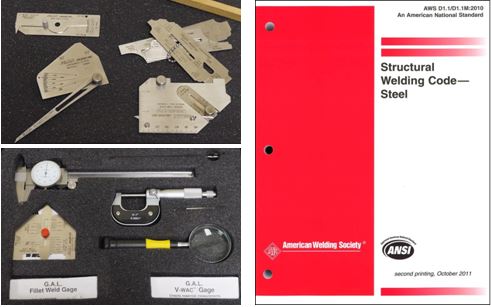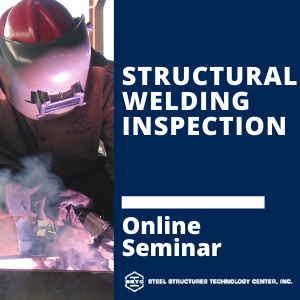Browsing Welding Inspection Gilbert Arizona: Crucial Insights for Market Professionals
Wiki Article
Welding Examination Demystified: Key Processes, Devices, and the Necessary Function They Play in Keeping High-Quality Welds
Welding inspection functions as an essential backbone in the guarantee of architectural honesty and top quality in bonded joints, affecting numerous sectors from building and construction to manufacturing. This procedure is not merely a formality; it encompasses essential techniques such as visual assessments and advanced non-destructive testing methods developed to reveal defects that can compromise security. With a selection of specialized tools at their disposal, inspectors play a crucial role in keeping high requirements. The complexities of these methods and their ramifications for top quality assurance continue to be usually overlooked. What are the key procedures and devices that make certain these requirements are promoted?Value of Welding Examination
Making certain the integrity of bonded joints is paramount in various sectors, making the significance of welding evaluation indisputable. The high quality of welds directly influences the safety, efficiency, and long life of components and frameworks. In sectors such as building and construction, automobile, aerospace, and production, any kind of failing in bonded joints can lead to disastrous repercussions, including architectural failures, equipment breakdown, and loss of life.Welding evaluation functions as a vital quality assurance procedure, guaranteeing that welds fulfill defined criteria and regulative requirements. It identifies flaws such as cracks, porosity, and incomplete blend that may compromise the toughness of the weld. By detecting these issues early, welding assessment can prevent expensive rework, delays, and possible safety threats.
In addition, welding examination promotes compliance with industry criteria and certifications, improving the reliability of organizations and their products. It likewise sustains constant renovation by providing valuable feedback to welding employees, enabling them to improve their strategies and processes.
Eventually, the value of welding inspection can not be overstated; it is crucial for keeping high-quality welds, making sure safety, and protecting investments across different markets.

Key Evaluation Processes
Effective welding evaluation counts on a collection of essential processes made to review the top quality and honesty of welds. These processes encompass both non-destructive and aesthetic screening (NDT) approaches, making certain that any kind of defects are identified before they endanger structural honesty.The initial step in the examination process is a thorough aesthetic assessment, which permits examiners to examine welds for surface flaws such as fractures, undercuts, and incomplete combination. Complying with aesthetic checks, various NDT techniques may be employed, consisting of ultrasonic testing, magnetic particle testing, and radiographic screening. Each method provides unique benefits; for example, ultrasonic testing can identify internal defects, while radiographic testing gives a long-term document of the weld's inner structure.
Furthermore, it is critical to confirm conformity with appropriate codes and requirements, making sure that the weld fulfills market specifications. This consists of inspecting weld measurements and positioning, as improper dimensions can result in failings under lots.
Crucial Tools for Evaluation
Consistently using the right devices is crucial for accomplishing precise welding assessments. A detailed collection of assessment devices aids ensure that welds satisfy stringent quality requirements and specs.Among the primary tools is the aesthetic inspection gauge, which enables assessors to analyze surface area problems, such as tidiness and surface area finish, directly. In addition, micrometers and calipers are crucial for measuring weld measurements and guaranteeing they adapt to look at this site needed resistances.
For even more read this comprehensive analyses, ultrasonic testing (UT) equipment is invaluable. This approach utilizes high-frequency acoustic waves to examine and find inner flaws material density. In a similar way, magnetic particle screening (MT) and color penetrant testing (PT) are critical for determining surface and near-surface problems, offering prompt aesthetic signs of possible issues.
Welders ought to additionally be furnished with firmness testers, which examine the mechanical residential properties of the weld steel and base products, guaranteeing they satisfy given requirements. Recording searchings for with electronic inspection devices improves traceability and high quality control. By using these important tools, assessors can keep top quality welds, ultimately contributing to the security and dependability of welded structures.
Typical Defects and Their Discovery
Welds, comparable to the foundation of structural stability in construction and production, can display numerous defects that compromise their efficiency and security. Common issues consist of porosity, cracks, undercut, absence of blend, and slag incorporations (Welding Inspection Gilbert Arizona). Each of these defects can show up due to improper welding techniques, bad material choice, or poor preparation
Detection of these problems can be attained through different non-destructive testing methods, including aesthetic assessment, ultrasonic screening, and radiographic screening. Each method plays a critical duty in recognizing these faults, making sure that the integrity of the weld is preserved and decreasing the danger of failing in essential applications.

Best Practices for Quality Control
Ensuring the finest quality of welds is vital for architectural stability and security, especially in markets where the effects of failing can be extreme. To accomplish this, several ideal methods for high quality assurance must be executed throughout the welding process.
First, a durable welding procedure requirements (WPS) should be established, describing the necessary parameters for each welding operation. This makes sure consistency and adherence to sector requirements. Second, complete training and certification of welders are necessary; competent employees are much better furnished to create high-quality welds and identify potential problems.
Routine assessments need to be incorporated right into the welding procedure, using both aesthetic and non-destructive testing (NDT) approaches to identify flaws beforehand. Regular calibration of assessment tools find is essential to preserve accuracy. In addition, documenting all welding tasks, consisting of assessments and restorative activities, develops a deducible record that can be important for top quality control.
Final Thought
In final thought, welding inspection works as a vital mechanism for making sure the honesty and reliability of welded joints across industries - Welding Inspection Gilbert Arizona. Via the application of key assessment procedures and the utilization of important devices, companies can properly identify and address potential defects. Adherence to finest techniques in top quality guarantee not only boosts safety yet additionally makes certain compliance with sector criteria, ultimately adding to the long life and efficiency of parts and structuresWelding evaluation serves as a vital backbone in the assurance of architectural honesty and high quality in welded joints, affecting various sectors from construction to manufacturing.Ensuring the integrity of welded joints is critical in numerous industries, making the significance of welding assessment undeniable.Welding evaluation serves as an important high quality control step, ensuring that welds fulfill specified criteria and regulative demands. By employing these necessary tools, inspectors can keep high-quality welds, ultimately adding to the safety and integrity of bonded frameworks.
In conclusion, welding inspection offers as a crucial mechanism for making certain the honesty and integrity of welded joints throughout markets.
Report this wiki page